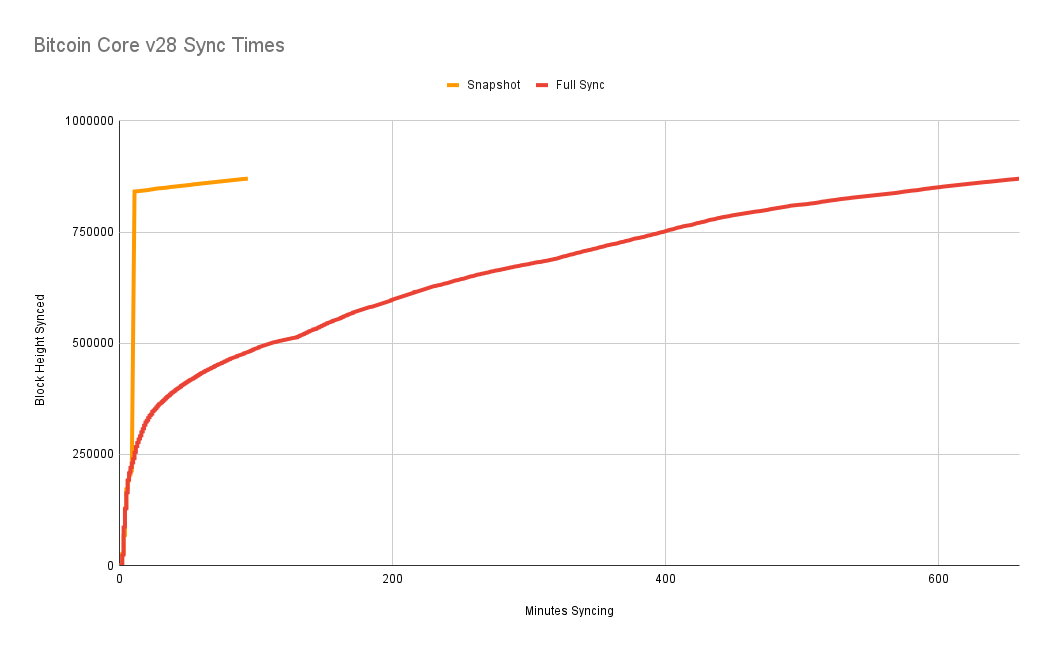Boost Your Bitcoin Node Sync With UTXO Snapshots

The recent Bitcoin Core v28 release added support for a new feature that has been under development for 5 years. First proposed in 2019 by James O’Beirne, AssumeUTXO enables full nodes to defer verification of old blockchain history by loading a recent snapshot of the UTXO set at a specific block height and syncing to chain tip from that point. This allows wallets and other software using the full node to start receiving and sending transactions within minutes of the node being started instead of having to wait hours or days for it to sync and validate the chain from the genesis block.
When you use AssumeUTXO, the node starts syncing from the snapshot to the chain tip, then the node downloads and verifies the old blockchain history in the background until it eventually verifies its initial UTXO state at the loaded snapshot, allowing it to ultimately obtain the same trustless security as a node that doesn’t use AssumeUTXO.
How to Use UTXO Snapshots
- Download a UTXO Snapshot file. You can find one for block height 840,000 on my site or from this torrent:
magnet:?xt=urn:btih:596c26cc709e213fdfec997183ff67067241440c&dn=utxo-840000.dat&tr=udp%3A%2F%2Ftracker.bitcoin.sprovoost.nl%3A6969 - Download Bitcoin Core v28 or later.
- Run Bitcoin Core but prevent normal peer syncing:
bitcoind -daemon -maxconnections=0 - Load the snapshot via:
bitcoin-cli -rpcclienttimeout=0 loadtxoutset /path/to/utxo-snapshot-height-840000.dat - Wait for the command to finish (this will take tens of minutes to several hours depending upon the speed of your machine)
- Once the command finishes, your node's sync progress will jump forward to the block height of the snapshot.
- Restart Bitcoin Core with peer connections enabled.
bitcoin-cli stop && bitcoind -daemon - After it reaches chain tip, the node will start performing a sync from genesis in the background, but the node will be usable during that time.
Frequently Asked Questions
- Does it matter where I get the snapshot dat file from? No; Bitcoin Core will only load a snapshot with an aggregate UTXO set hash that matches one that's hard coded into Core.
- Can I create my own snapshots and load them? You can generate snapshots with the
dumptxoutsetRPC command or with this utility script. However, you won't be able to load a snapshot unless it's at one of the block heights hard coded into Core. At time of writing, the only supported height is 840,000. - Can I use this to sync a pruned node? Yes.
- Can I use this to sync a node with indexes enabled? Yes, though it won't make building the indexes any faster - they still have to be generated linearly from genesis.
How Much Faster Does the Node Sync?
I ran two syncs of Bitcoin Core v28 on my benchmark machine with full default settings. One sync ran entirely from genesis while the other loaded the snapshot as soon as it started syncing.
It took 10 minutes for the node to load the snapshot, then it took 84 minutes to finish syncing to chain tip. On the other hand, it took 659 minutes to perform a full sync from genesis.

So we can see that the speedup is quite significant!
Is It Worth the Trouble?
You'll want to weigh some trade-offs when decided if you want to sync your node from a snapshot.
- How much of a rush are you in to be able to use your node?
- How fast is your node hardware? If it's really fast and can sync from genesis in less than a day, perhaps it's not worth the extra steps to load a snapshot. Something like a Raspberry Pi would likely find much greater benefit from loading a snapshot.
While I only expect that more technically savvy node operators who are comfortable operating on the command line will take advantage of this feature right now, it can certainly be worth the extra steps in order to get an order of magnitude speedup!
Perhaps in the future, Bitcoin Core could offer a bundled download that includes a recent snapshot that gets automatically loaded on startup so that less sophisticated users can also take advantage of this functionality.




